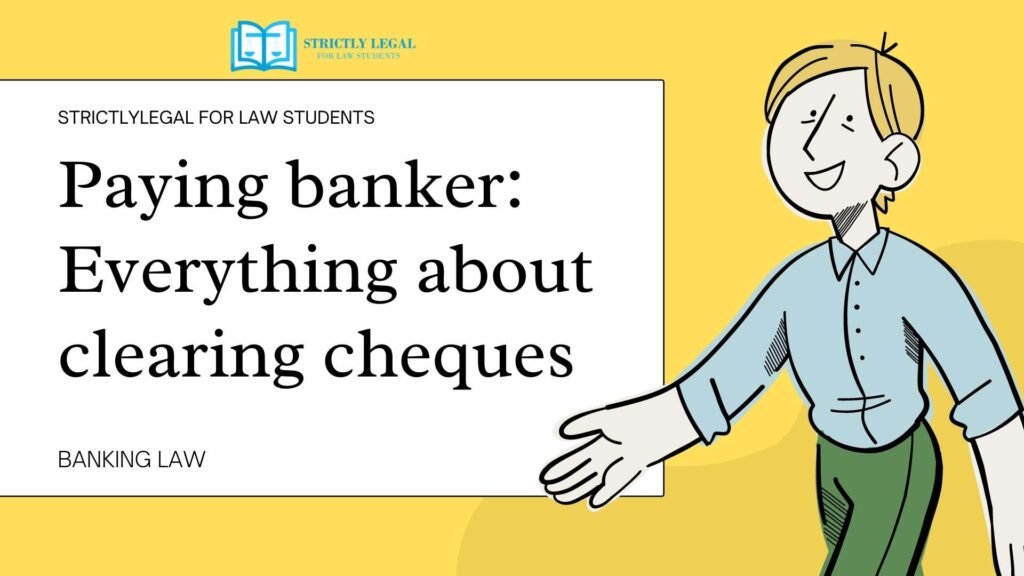In this article you will earn about Paying banker, his duties and responsibilities, the procedure of clearing cheques , and other relevant topics ancillary to the subject.
Table of Contents
Who is a Paying Banker?
A paying banker is the person who pays the cheque either to his customer or on the instructions of his customer. A cheque is a Negotiable instrument that orders a banker to pay when certain conditions are met.
For example: Ramesh is a customer of State Bank of India and has drawn a Cheque for Rs. 50,000 in the name of Suresh in exchange of goods purchased by him. Suresh, brings the cheque at his bank to clear the amount and encashes the cheque. The Bank from where he enchases the cheque is the Paying Banker in this situation. In other words, the drawee banker is the paying banker who pays the cheque of his customers.
Duties of Paying Banker
To honour a customer’s cheque is a paying banker’s statutory duty provided that the customer has sufficient funds and the cheque is in order.
Section 31 of the Negotiable Instrument Act even lays down that if the drawee customer has sufficient funds in his account applicable to the payment of such cheque must pay the amount when duly required. In case of any default on the side of the paying banker if the drawee of such cheque incurrs any loss or damage, it must be compensated.
31. Liability of drawee of cheque.—The drawee of a cheque having sufficient funds of the drawer in his hands properly applicable to the payment of such cheque must pay the cheque when duly required so to do, and, in default of such payment, must compensate the drawer for any loss or damage caused by such default.
Section 31 in The Negotiable Instruments Act, 1881
In other words, the negotiable Instrument Act has imposed upon the paying banker to honor cheques as per the provisions of law and any default on its part in breach of those provisions may lead to a suit for damages.
The damages may be claimed when the paying banker has denied payment of the cheque or has defaulted or dishonoured inspite of the following checks:
- There was enough funds in the customer’s account who has drawn the cheque.
- Such funds could be applied to the payment of the cheque by the banker.
- Such cheque was presented for payment within the banking hours.
- Such cheque was presented in proper time i.e not beyond validity.
It must be noted that currently, cheques drawn are valid for three months from the date on which it was drawn.
Statutory Protection to Banker
It is not just the responsibility to honor cheques of the drawee but also the responsibility to protect the drawee from fraudulent practices. Section 85 of the Negotiable Instruments Act, 1881 gives statutory protection to the paying
banker when it has dishonored cheques on genuine grounds.
The Negotiable Instruments Act, Sec. 85, governs Indian law in this aspect. A banker is always the payee of a check. Bankers are given a distinct advantage when it comes to the payment of checks under this clause. According to the section, if a cheque payable to order purports to be endorsed by or on behalf of the payee, and the banker on whom it is drawn pays it in due course, the banker is discharged, and he can debit his customer with the amount so paid, even if the endoresement was placed on the cheque by the payee’s agent without his authority.
The Section’s objective is to exclude the banker from liability for the genuineness or legality of an endorsement purported to be signed by the payee or his authorised representative. This clause would also apply to an endorsement other than the payee’s, based on Section 16(2). The Nagar Central Bank Ltd. v. Jagjiwandas The clause does not apply to the payment of bills of exchange or promissory notes issued by customers.
To be eligible for protection under this section, the banker must show that the payment was made in good faith, in line with Section 10 of the Act. As a result, good faith and the lack of fault must be established.
Case laws:
In Jogendra Nath Chakrawarti v. New Bengal Bank Limited, it was held as under:
“Where the Banker, being bound to honour his customer’s cheque, has failed to do so, he will be liable in damages. If, special damage, naturally ensuing from the dishonour, is proved, it will be properly taken into account in assessing the amount of the damages. If the customer be a trader, the Court may properly award substantial damages, in the absence of proof of special damages. In other cases the customer will be entitled to such damages as will reasonably compensate him for the injury which, from the nature of the case, he has sustained. All loss flowing naturally from the dishonour of a cheque may be taken into account in estimating the damages.”
AIR 1939 Cal 63
In Mohamed Hussain v. Chartered Bank, it was held as under:
“As negligent act may be the effective cause of an injury though it may not be proximate in time, if it is the particular incident, in a chain of events which has in fact led to the injury, that is, if it is the real cause of subsequent accident. To determine responsibility the law will consider the proximate and not the remote cause of an injury.”
AIR 1965 Mad 266
Tindal, C.J. in Davis v. Carret, at page 1030 held as under :
“no wrong doer can be allowed to apportion or qualify his own wrong and that as a loss has actually happened whilst his wrongful act was in operation and force, and which is attributable to his wrongful act, he cannot set up as an answer to the action the bare possibility of a loss, if his wrongful act had never been done.
What are the precautions to be taken by the paying banker explain?
In that case a paying banker must exercise extreme precautions while making the payments in due course of his duty. Here’s a few things that he must keep remember:
- Form of Cheque: The form of cheque placed before him must be in valid form and not damaged or torn or cancelled. The signature must be authenticated to verify the issuer.
- Date of Cheque: The cheque must not have been issued before 6 months. It must bear the date clearly on which it was issued.
- Amount of Cheque: The amount should be mentioned without fail in words and in numbers. Both the amount in words and in numbers must match. It should be written in a way that any insertion or alteration is impossible.
- Fund of the customer: The customer who has drawn the cheque must have sufficient funds in his account to clear the cheque. In case of insufficient funds the cheque is bounced. There cannot be a partial payment, the cheque must be paid in full by the paying banker at all times or outright reject it altogether.

Passionate about using the law to make a difference in people’s lives. An Advocate by profession.





